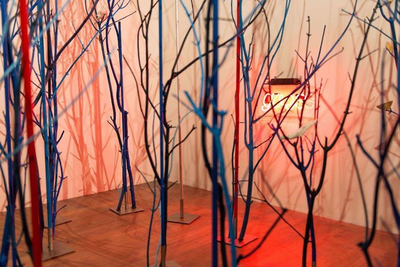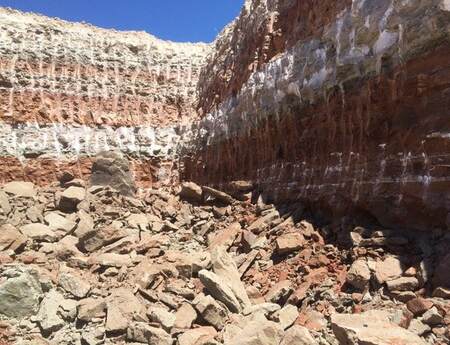Exchange Ideas Online: Report of The Online Club
For The Online Club’s 6th edition, two sculpture network’s members – Patricia McKenna and Karin van der Molen – presented collective projects centered around nature art and unconventional approaches to time, landscape, and connectedness.
In response to the limitations during the Covid-lockdown, sculpture network initiated The Online Club, allowing participants from all around the world to meet, exchange ideas, and communicate their enthusiasm for three-dimensional art.

Nature art: Layers of landscapes and time
Patricia McKenna, a multi-media and installation artist from Ireland, presented projects by the Karum-Creevagh Experimental Heritage Collective – a group of archaeologists and artists who aim to establish a trans-disciplinary and trans-local practice of Experimental Heritage in a Swedish-Irish context. Interested in archaeology, heritage, and themes concerning the past, the present, and the future, the members of the collective develop cross-cultural and cross-disciplinary exchanges.
Interestingly, landscapes of the Burren (Ireland) and the island of Öland (Sweden) boast similar characteristics – limestone and underground water – but at the same time remain vastly different. With the aid of combined artistic and archaeological practices, the collective explores landscapes’ similarities and differences.
Cross-disciplinary exchanges
Starting points for their investigations and experiments are: stone and water, movement and time, and material an immaterial aspects of landscape experience. As a result, a phenomenological landscape perspective is combined with movement-based practice. Their methods are paired with other artistic and archaeological expressions such as poetry, music, performance, visual arts, physical surveys, mapping, and excavations.
The strength of the Experimental Heritage Collective lies in its diversity and unconventional approaches to the natural environment. While the Swedish group consists of artists, archaeologists and an environmental consultant, the Irish body includes three archaeologists interested in landscape from diverse perspectives and five artists with a variety of creative disciplines, including contemporary dance and somatic movement practice, visual art, poetry, graphic design, photography, and curating.
Deep listening to the landscape

How archaeologists and artists – experts in separate disciplines – can collaborate with each other? The answer lies in deep listening. To experiment with heritage, the group has left the arenas of conventional art and archaeology research, communication and presentations. The constraints of convention are consciously substituted by alternative settings in the landscape. The project work includes collaborations with people from local communities too – ultimately contributing to the explorations with their perspectives, experiences, and stories.
The immaterial aspects of the landscape are communicated in a performative way – through sculpture, dance, readings, and music. The collective has already organized exhibitions in Sweden and Ireland, including large projections, short music videos, photographs, and poetry. Before the pandemic, they would visit each country twice a year: Sweden in autumn and Ireland in spring. Since 2020, the collective has moved online and have been developing the community digitally, eagerly awaiting the moment to resume physical interactions.

Sharing ideas online
Karin van der Molen from the Netherlands has been increasingly focused on environmental and site-specific art. Her practice revolves around the human relationship with nature, which can be seen in natural materials she chooses to work with. Her creation process involves extensive research and sensory explorations of locations where her artworks will be made. For many years, she has been participating in sculpture symposia all around the world, where she has met other sculptors passionate about nature art. Since 2020, however, artists have found themselves in a particularly tough position with so many exhibitions, and collaborations cancelled or postponed.
Crit group
To nurture already established relations with other like-minded artists, Karin set up a weekly crit group with the aim to support each other throughout this unprecedented time. First, the participants shared short videos to show what they were working on at the moment. Without a need to have a final product and no actual exhibition dates on the horizon, the artists had enough time to experiment and present their undertakings to fellow sculptors. Sharing videos, however, quickly turned into exchanging ideas, concepts, and inspirations.

It is vital for those interested in social aspects of art to discuss the broader context and how works resonate with other people. The group has been using different texts as a starting point for further investigations. Although physically confined in different locations (the group is genuinely international), the participants have managed to support each other through this unusual time. After numerous meetings, Karin created Wireless, an 18-minute long documentary about her cooperation with six international environmental artists during the Covid pandemic. Profoundly inspiring, the video gives an intimate insight into the ongoing learning process and stimulating conversations.
It has been over a year since the group was established, and they still meet regularly. Lately, the group has been discussing Staying with the Trouble (Experimental Futures) by Donna Haraway, a multi-species feminist theorist and one of the most daring and original thinkers of our time. The book offers provocative ways to reconfigure our relations to the earth and all its inhabitants within the context of the 21st century’s challenging reality. The group uses it as a starting point for studying connections with nature and considering new narratives for our seriously troubled ecosystem.
Invaluable interactions

While the Experimental Heritage Collective has built bridges between archaeologists’ and artists’ practices, the supportive group that Karin van der Molen set up has nurtured the relations between artists, whose nomadic existence was abruptly interrupted by the Covid pandemic.
These two initiatives clearly show how beneficial unconventional and direct interactions are. While the pandemic poses numerous challenges to our daily life, staying connected is essential to both personal and professional development. To support fruitful collaborations and exchanges, sculpture network encourages interactions and welcomes further ideas for discussions centered around three-dimensional art.
karinvandermolen.nl
Film: Karin van der Molen, Wireless, 2021, 18.20 min.
www.youtube.com/watch?v=MIdDYbvJ5mI
Patricia McKenna: http://patriciamckenna.ie/
emperimentalheritage.com
Films:
Experimental Heritage Collective - Moving the Ship, concept Bodil Petersson by Hans Gurstard-Nilsson with Bodil Petersson and Maria Kerin, 2019, 6 min.
https://play.lnu.se/media/t/0_cpxu3dbk
About Experimental Heritage Collective, 23 min. https://youtu.be/VEgRXkjYEnE
Experimental Heritage Collective, Dowsing for Eels, Maria Kerins, Danny Burke, The Burren Co Clare, Ireland 9.42 min. https://play.lnu.se/media/t/0_dzhe5spr
Author: Marek Wolynski (Poland, lives and works in London, UK) is a London-based curator, creative producer, writer, and contributor to international art magazines. His practice has been increasingly focused on innovative public engagement and developing visceral, multi-sensory experiences. Marek is particularly interested in the interplay between art, nature, and technology.
Cover picture: Experimental Heritage - Moving the Ship by Hans Gurstard - Nilsson with Bodil Petersson and Maria Kerin






